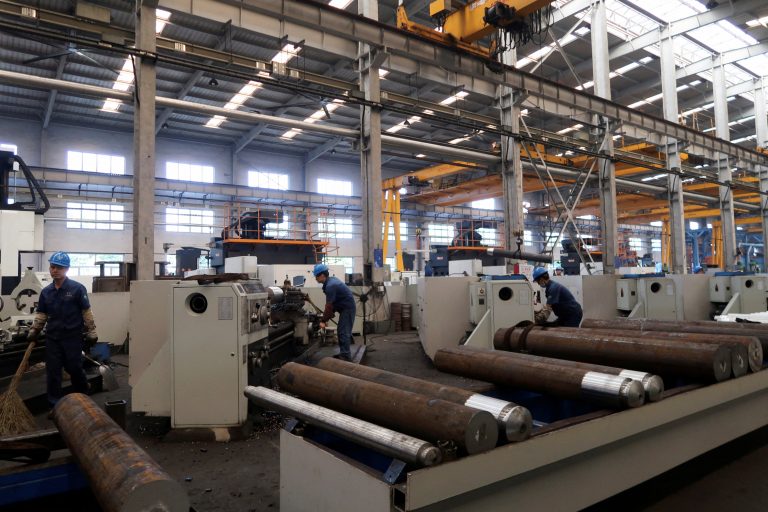According to several studies, the overall production capacity of factories worldwide shrank in June due to lagging demand in China and Europe which muddled the forecasts for suppliers.
Production revved up in Asia, but more was needed to stem the downturn in South Korea and Japan.
In the Eurozone, the contraction has accelerated even faster after the European Central Bank almost completely turned off the money tap to curb inflation, resulting in even lower manufacturing activity, with the U.K. taking the crown in terms of low expectations.
U.S. figures for the first half of 2023 are expected on Monday, but pundits say the crisis reigns supreme there, too.
‘China dragging its feet’
Studies show that the stunted recovery of Chinese industrial output after a period of severe economic downturn resulting from the disproportionate COVID measures has inhibited surrounding countries’ economies. Meanwhile, export tariffs imposed by the EU and the U.S. are further driving the appetite for manufacturing downward.
Success
You are now signed up for our newsletter
Success
Check your email to complete sign up
“The worst may have passed for Asian factories, but activity lacks momentum because of diminishing prospects for a strong recovery in China’s economy,” said Toru Nishihama, chief emerging market economist at Dai-ichi Life Research Institute.
“China is dragging its feet in delivering stimulus. The U.S. economy will likely feel the pain from big rate hikes. These factors all make Asian manufacturers gloomy about the outlook.”
The private survey showed that China’s Caixin/S&P Global Manufacturing Purchasing Managers’ Index (PMI) eased to 50.5 in June from 50.9 in May.
Asian development
As for the other Asian counties, the Korean PMI is still on its now 12-month plunge due to slumping demand in China and Europe with no end in sight.
Their consecutive PMI surveys highlighted that factory output also plummeted in Taiwan, Vietnam, and Malaysia.
The same downward trend was also reflected in Japan’s Jibun Bank PMI drop to 49.8 points after showing a slight pick-up for the first time in May after seven months of contraction, while Overseas orders plummeted for Japanese enterprises at the fastest pace in four months due to reduced demand from China.
However, the Tankan study used as a gauge by Japan’s Central Bank showed that Japan’s manufacturing morale somewhat rebounded thanks to the lifted COVID measures, which boosted consumption again in the second quarter, despite increased commodity prices.
READ MORE:
- China Travel Spending Figures Show Economy Worse Than 2019
- China Censors Finance Influencers While Stock Market Hurts
- China Unveils $72 Billion Tax Break for Electric Vehicles Amidst Weakening Demand
- Premier Li Qiang Talks Up China‘s Growth at World Economic Forum Meeting
There were bright patches among the economic indicators, with India’s manufacturing industry bucking the trend and expanding briskly in June, albeit slightly slower than in May, supported by robust demand.
In forecasts released in May, the International Monetary Fund expects Asia’s economy to expand by 4.6 percent this year after a 3.8 percent gain in 2022, contributing around 70 percent of global growth.
Recently, however, the IMF downgraded the expected growth of the Asian economy to 4.4 percent and warned of risks to the prospect, such as tough inflation and sluggish global demand.
The development of the Asian economy thus has a huge effect on that of Europe and America. At the same time, they succumbed to the effects of unilaterally imposed tariff wars and self-inflicted trade embargoes, counter-effective Covid measures, manufactured deficits, and the repressive monetary policies pursued by the various governments at the baton of the national and supranational banks.
Eurozone: a negative assessment
All four of the eurozone’s biggest economies contracted last month, showed surveys published earlier this month demonstrating that June’s downturn in Europe’s factory activity was broad-based.
Compiled by S&P Global, HCOB’s final eurozone manufacturing Purchasing Managers’ Index (PMI) fell to 43.4 from May’s 44.8, its lowest since the COVID pandemic was paralyzing the world’s economy below a preliminary reading and further from the 50 mark separating growth from contraction.
The S&P Global/CIPS UK Manufacturing PMI fell to 46.5 from 47.1 in May, its lowest reading this year and one of the weakest since the 2008-09 financial crisis.
“There are no real signs we are going to get any rebound in the manufacturing sector this year. On the whole, we are still talking about a negative assessment,” said Rory Fennessy, European economist at Oxford Economics, on the eurozone release.
Reuters contributed to this report.

















